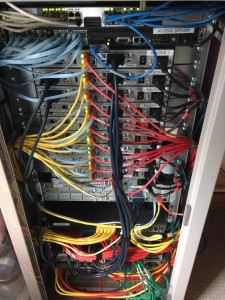For my CCIE study I decided to go down the route of getting my own equipment and pulling my own lab environment together.
Before I came to that decision, I weighed up all my options as I knew it wasn’t going to be particularly cheap.
I was already using GNS3 extensively and this was my primary method of creating labs and test environments, however for those of you that have used GNS3 I am sure you are aware that there are some limitations and in my opinion nothing quite beats getting your hands on real kit.
One thing that needs to be taken in to account, if going down this route, is the overall cost of the lab – including running it.
It took me quite a while to build my lab up to how I wanted it, with most of it being purchased off Ebay. I would really recommend Ebay as I managed to get some real bargains. Unless you have endless pots of money to buy all new kit – or work are willing to fund it.
My lab at the moment consists of the following:
- 9 x ISR 1841 routers
- 1 x ISR 3825 router
- 1 x ISRG2 1921 router
- 1 x 2522 router
- 1 x AS2511-RJ router
- 1 x 2960G switch
- 1 x 3550 switch
- 1 x 3750G switch
- 4 x 3750X switches
- 8 x WIC-1T cards
- 4 x WIC-2FE cards
All of this kit is housed in a 24U network rack that sits in my office next to my desk.
I have some other kit that sits in here as well including:
- 1 x ASA 5510
- 1 x ASA 5505
- 1 x APC AP7951 PDU
- 1 x APC AP7921 PDU
The ASA’s I have mainly for lab work to write and test out configurations. I also have the 5505 setup as a VPN server so I can connect in to my home network remotely.
The PDU’s are excellent and allow me to remotely power up or down the equipment using individual outlet controls – and power cycle the kit if it becomes unresponsive. Another good thing is I can monitor the current draw from the socket – which is really useful on a 13A socket!
Cold starting all the kit at once peaks between 5-6 Amps, then once its all settled runs at just under 4A continuously. I have set alarms on the PDU so if the Amps drawn exceeds 7A an alarm will be raised and it will not allow you to power on any more sockets and at 9A it will reach the overload alarm threshold.
When settled it doesn’t make too much noise (don’t know what the dB is) but to be honest when studying I normally sit with my headphones on listening to music so don’t notice it. As you would imagine it generates a bit of heat – which is great on cold nights – however during the summer wasn’t as good, I left the door open to the office and ran a small air conditioner in there just to make sure (I’m am sure it would have been OK without the aircon).
I have cabled the kit in a similar fashion to INE’s example so it is easy to create new lab designs without actually having to re-cable the lab every time. The WIC-1T cards are static and all the serial cables connect to a frame-relay switch (2522).




